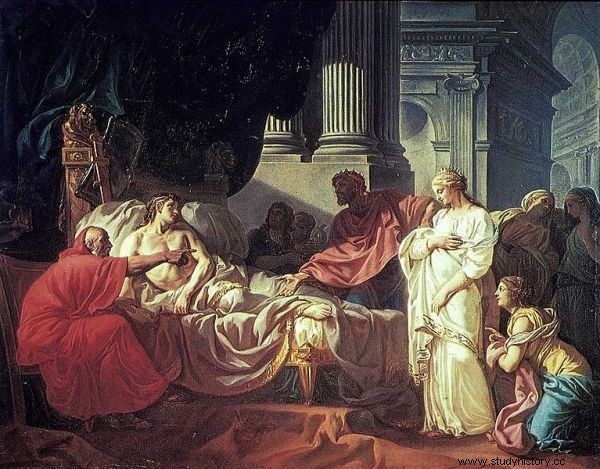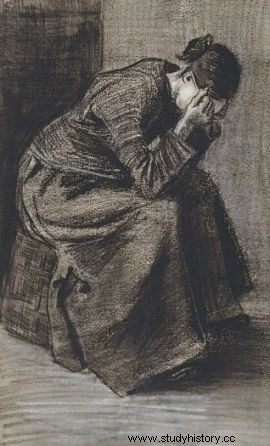Love can be like a disease. Literally. For centuries, doctors went above and beyond to help its victims. Burning with white-hot iron, bloodletting, applying leeches or whipping. These and many other drastic methods have been used to heal a broken heart.
Since antiquity, healers, paramedics and doctors were well aware of the fact that the most important activity leading to the cure of a patient is the correct diagnosis. To this end, they eagerly spent time at the home of wealthy patients. They tasted exquisite drinks, filled their stomachs and slowly pondered the chance they encountered.
Love is a terrible affliction!
When the symptoms were difficult to identify and the relatives and relatives of the patient showed signs of impatience, the experienced physician seized the last resort. He used to announce that all the commotion was a melancholy of love , and provided appropriate treatment.

A diagnosis of Antiochus I Soter, who turned out to be sick with love.
The more talented successors of the great Hippocrates in the course of their medical career developed even detective methods of diagnosing this very serious human ailment. The Persian physician and philosopher Avicenna (10th-11th centuries AD) has almost perfected it. He usually took the patient's hand and spoke the names of the districts one by one, waiting for the subject's reaction. In this way, he was able to define with extreme precision not only the district, but also the street and house number, and consequently to know the name of the patient's object of sighs.
In love, howls like a wolf and then dies…
Medics, often encountering the symptoms of amorous melancholy, were soon tempted to describe the course of this dangerous disease. Already in the ninth century, a certain Rhazes, also from Persia, described with great care the successive stages of the afflictions through which, in his opinion, the infected went through. With all his authority, he stated:
First, the human eyes collapse, pimples appear on the tongue, and then the body withers. Then the patient gurgles and his skin blisters, and doomed to extinction howl like a wolf and dies .

The Persian scholar Rhazes quite specifically described a dangerous ailment commonly known as love.
What a picturesque description. It is hard to shake off the impression that many of the authors and directors of the so-called The "soap operas" are unconsciously inspired by the observations of Rhazes. The torments experienced by their heroes often resemble the symptoms described by the Persian, gifted with vivid imagination.
… or is it just a lack of appetite?
When the first physician diagnosed the patient with love sickness, he immediately started treating it. His colleagues did no differently.
Further ambitious doctors at the turn of the century continued his efforts, constantly inventing new measures for this unusual ailment.
The pain caused by the torment given to the patients was probably many times greater than that resulting from a broken heart.
Faeces and body fluids - the best medicine for a broken heart
Many former medics believed that the rule of thumb in cases of sickly infatuation was to keep the suffering patient's brain moist.

When the patient's condition did not improve and the patience of his family wore off, the physician could always say that he was in love.
For this purpose, the unfortunate man was obliged to constantly smell his beloved's menstrual pads or glowing in the fire of her excrement . Surprisingly, there were difficult patients for whom this type of treatment was not enough.
Undaunted, doctors used to pull heavier cannons back then. The bloodletting worked perfectly, according to some people. It was, however, until the nineteenth century, a therapy for everything. In more severe cases, the blood was drawn from the patient until "complete heart failure occurs".
Another method used sometimes was acid stinging the thighs . This treatment was usually used when there was a danger that a patient or a patient who was mad with love would soon turn into a bloodthirsty werewolf.

Was it love that caused this sadness? | If so, we have ways. Pretty drastic ways…
Hemorrhoids and pig over bed
Hippocrates (5th-4th century BC), mentioned at the beginning, was firmly convinced that fell in love perfectly heal hemorrhoids, and their burnout is equal to extinguishing the love of love . According to other medics, the patient's whipping or the very experimental method - hanging a live pig over the sick bed - worked well. The animal's shrill squeal was meant to banish any unwanted thoughts for good.
Due to the fact that many former medics, in addition to imitating their colleagues, also looked for their own solutions, there were lucky ones who underwent less drastic procedures. And so, Avicenna's patients sometimes underwent quite pleasant shock therapy, whereby a loving sufferer should be offered further objects of his sighs and be careful that they change before the patient succumbs too much to them.
The prescient doctor assumed that sooner or later the tormented person would return to the world of the living and take care of worldly matters.

If you are unlucky enough to hit Amor, don't break down. There is still hope.
When this final weapon also failed, Avicenna paid a few pennies to some dreadful gossip to tell the sick man uncreated stories about his chosen one , thereby ending the therapy.
It seems that the last of the mentioned methods of treatment is also used today with positive results in many difficult cases. Nothing but fall in love!
